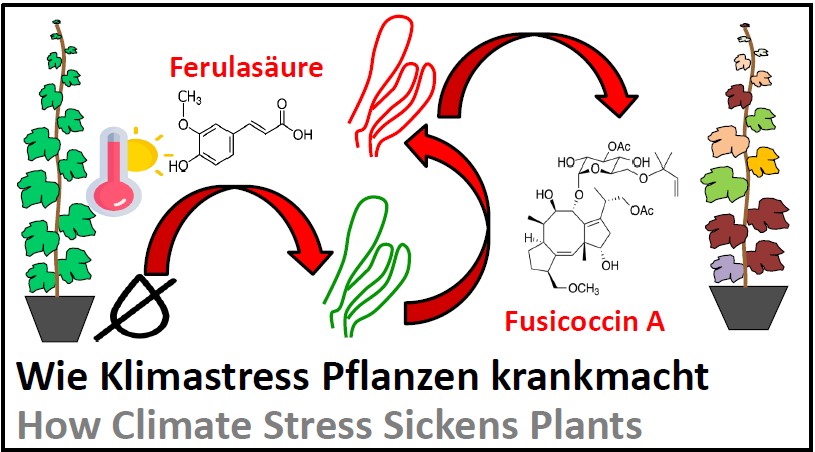2022_04 Suicide Signal for Grapevines
 |
What was the question behind this work? Grapevine Trunk Diseases are actually stress-related. The causing fungi can live many years in the wood without causing symptoms. However, when the plant is facing climate stress, as it happens more and more often even in our country, the fungus can sense this and kills its host. The evolutionary meaning behind this behavioural change is the need to search for a new host. The hot and dry summers make also in our region grapevines collapse in the blossom of their productivity. Hereby, the fungus uses the energy from the „corpse“ for sexual propagation, in order to generate fruiting bodies that can then break out from the wood and disperse the spores. This syndrome is not new – in fact, the first description comes from an Arabic book about agriculture that appeared in the 12th century in Sevilla. What is new, however, is that this hitherto sporadic phenomenon is now turning epidemic and produces tremendous damage. What did we find out? In a cooperation with the Institute for Bioactive Compounds (IBWF) in Kaiserslautern we succeeded in identifying two of these signals. Under stress the grapevine trunk accumulates ferulic acid because this precursor of lignin, the building block of wood, cannot be integrated properly. The fungus Neofusicoccum parvum has "learnt" to use ferulic acid as signal for an ensuing crisis of its host and responds to this signal by formation of Fusicoccin A, which is a signal as well. Fusicoccin can induce programmed cell death, driving the grapevine cells into suicide, a response that is actually meant to ward off so-called biotrophic pathogens. What can we do whith this knowledge? There are two therapies – we can search for grapevines that accumulate less ferulic acid even under drought stress, such that the fungus is kept peaceful. In fact, we succeeded in spotting wild grapevines that can channel their metabolism towards defence compounds (so-called stilbenes) and know how to defend themselves. (more...). These grapevines could now be used to breed climate resilient varieties. As short-term therapy we can try to activate plant immunity to reach the same effect. This is, what we currently pursue in frame of our project Microbes 4 Future (more...). Publication Khattab I, Fischer J, Kazmierczak A, Thines E, Nick P (2022) Hunting the plant surrender signal activating apoplexy in grapevines after Neofusicoccum parvum infection. Plant Cell Environment doi.org/10.1111/pce.14468 - pdf INTERVIEW IN THE KIT CAMPUSRADIO
|
